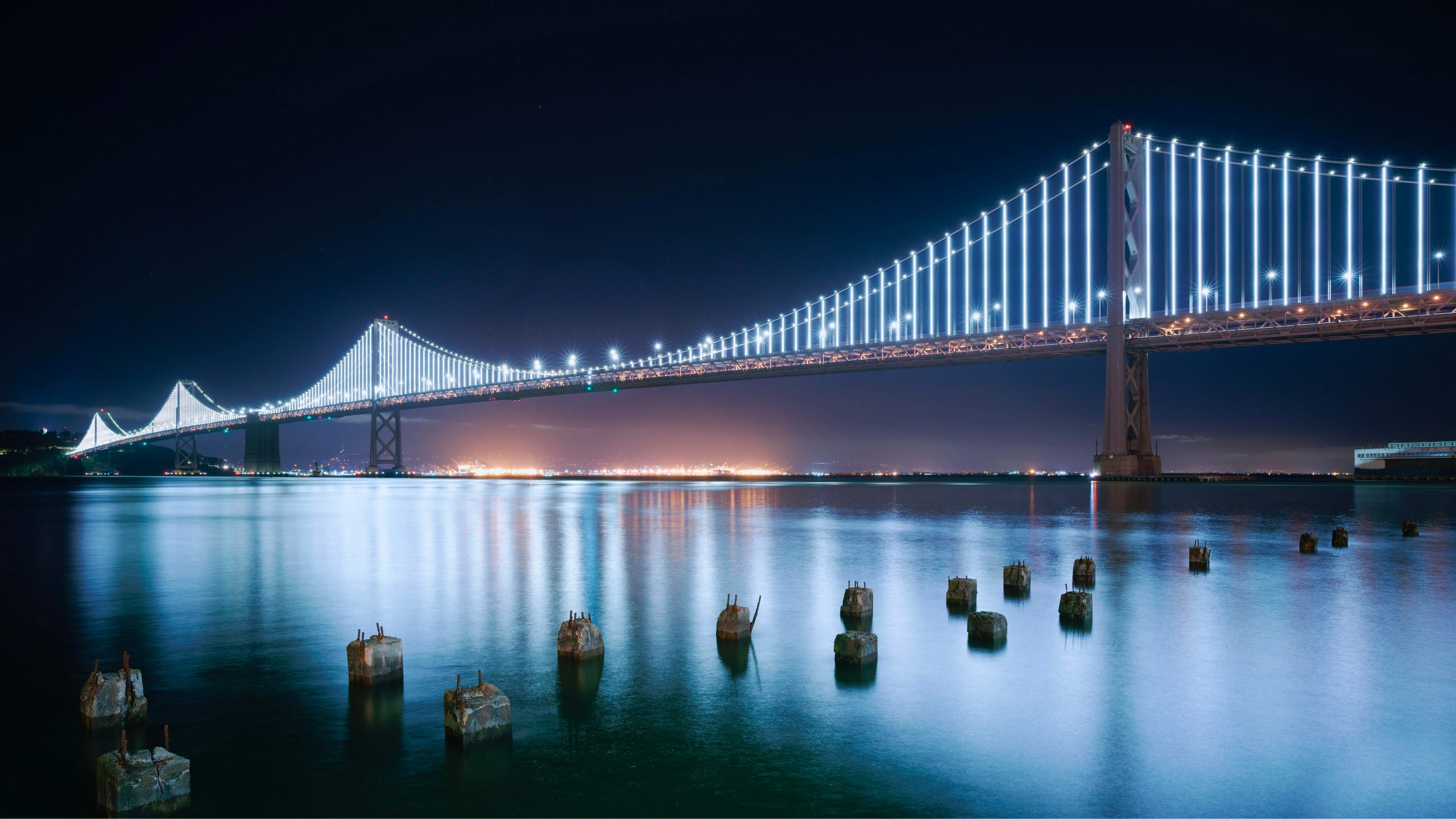 Photo Credit: Dllu/Wikimedia Commons
Photo Credit: Dllu/Wikimedia Commons
Redefining Urban Narratives
Issue No. 010
San Francisco’s Leap from Doom Loop to Boom Loop
Media hype suggests that San Francisco has entered an “urban doom loop.” Remote work sucked the life out of downtown; drug dealers, addicts, and crime swooped in; real estate values nosedived and tax revenues plummeted. As the city cuts services, the doom loop becomes an unstoppable vortex. And as San Francisco goes, so goes Silicon Valley and the entire Bay Area.
While there’s no question San Francisco is in crisis, it’s a self-inflicted one that started well before the pandemic. Dysfunctional leadership allowed homelessness, drugs, and crime to flourish in the name of social and economic equity. Civic mismanagement strangled new housing production. Anti-business legislative, regulatory, and tax policies — such as Proposition C, which penalized firms earning more than $50 million annually — sparked an exodus of large employers. If tech was the economic goose that laid the golden egg, government leaders effectively suffocated its potential. Covid-19 simply compounded the effects.
While there’s no question San Francisco is in crisis, it’s a self-inflicted one that started well before the pandemic.
The silent majority has finally awoken. A multifaceted grassroots movement is pursuing common-sense solutions and a politics of moderation is underway. It began with the recall of former district attorney Chesa Bodin and three school-board members. It continued with district attorney Brooke Jenkins’ efforts to restore consequences for criminal behavior, and the election of two moderates to the Board of Supervisors. The uprising has now attracted ordinary citizens, who question why homeless nonprofits funded by the government are suing the city instead of solving the problem, and exactly where the hundreds of millions of dollars in taxes raised by Prop C for “homeless services” are actually going.
The silent majority has finally awoken. A multifaceted grassroots movement is pursuing common-sense solutions and a politics of moderation is underway.
The momentum has shifted. Rather than a “doom loop,” we believe a “boom loop” is already underway in San Francisco.
a Global Innovation Hub
San Francisco continues to build on its dynamic history of innovation. Green shoots are evident in the $25.7 billion in venture capital (VC) invested in the city in the first quarter of 2023 alone, and in the growing wave of artificial intelligence startups. Some 40% of companies on the Forbes AI 50 List are based in San Francisco, including 11 of the top-funded firms. Open AI just subleased 486,000 square feet from Uber in Mission Bay, one of the city’s largest office deals in more than half a decade. Its competitor Anthropic leased 230,000 square feet from Slack. Pear VC just moved from Palo Alto to Mission Bay. Hayes Valley has been dubbed “Cerebral Valley” because of all the AI startups and hacker houses sprouting up.
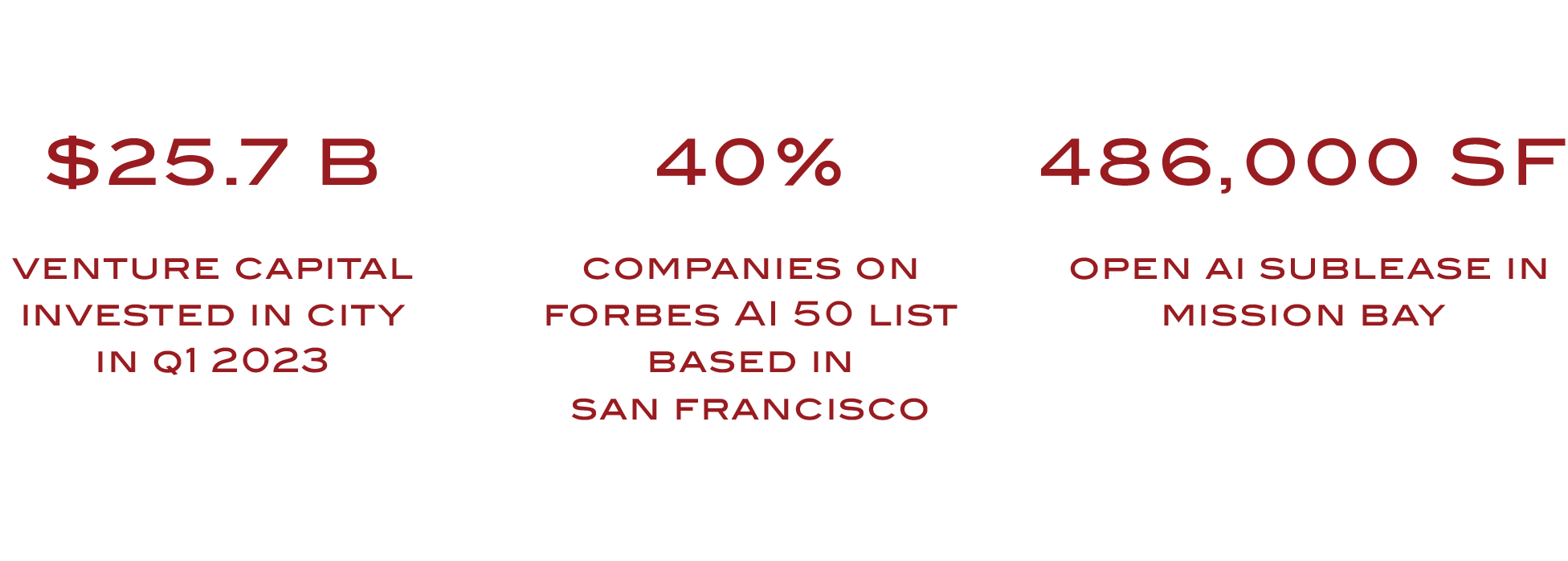

Ingenuity begets employment. More than one in five AI job postings are from companies headquartered in San Francisco, according to Comprehensive.io. Some analysts suggest that overall hiring may be lean, because AI engenders productivity that replaces human jobs. But unlike earlier tech waves which had a singular focus, such as the dot-com era, every industry today is tech-enabled, from finance and aeronautics to automotive and agriculture. Generative AI was named a top investment priority by 72% of 1,300 CEOs surveyed by KPMG in 2023. We anticipate an influx of companies seeking to harness the benefits of AI to remain competitive. For example, in the wholesale and retail banking sector, McKinsey Global Institute estimates that generative AI could add at least $200 billion in value through greater productivity.
AI will undoubtedly play a profound role in all industries going forward. This will cement San Francisco’s position at the center of the transformation and drive continued job growth.
In fact, some leading tech thinkers view the launch of Open AI’s ChatGPT as an advance on par with the introduction of the internet and the iPhone. The Effective Accelerationism (or “e/acc”) movement believes AI will inevitably lead to the creation of artificial general intelligence (AGI), a superintelligence that can carry out any task human beings now perform. E/accelerationists suggest that AGI has the potential to facilitate massive improvements in productivity, stability, and global prosperity, and fundamentally alter the structure of society, the economy, and politics. VC investors such as Marc Andreessen and Garry Tan have added “e/acc” in their usernames on X (formerly Twitter) as a nod to this vision. AI will undoubtedly play a profound role in all industries going forward. This will cement San Francisco’s position at the center of the transformation and drive continued job growth.
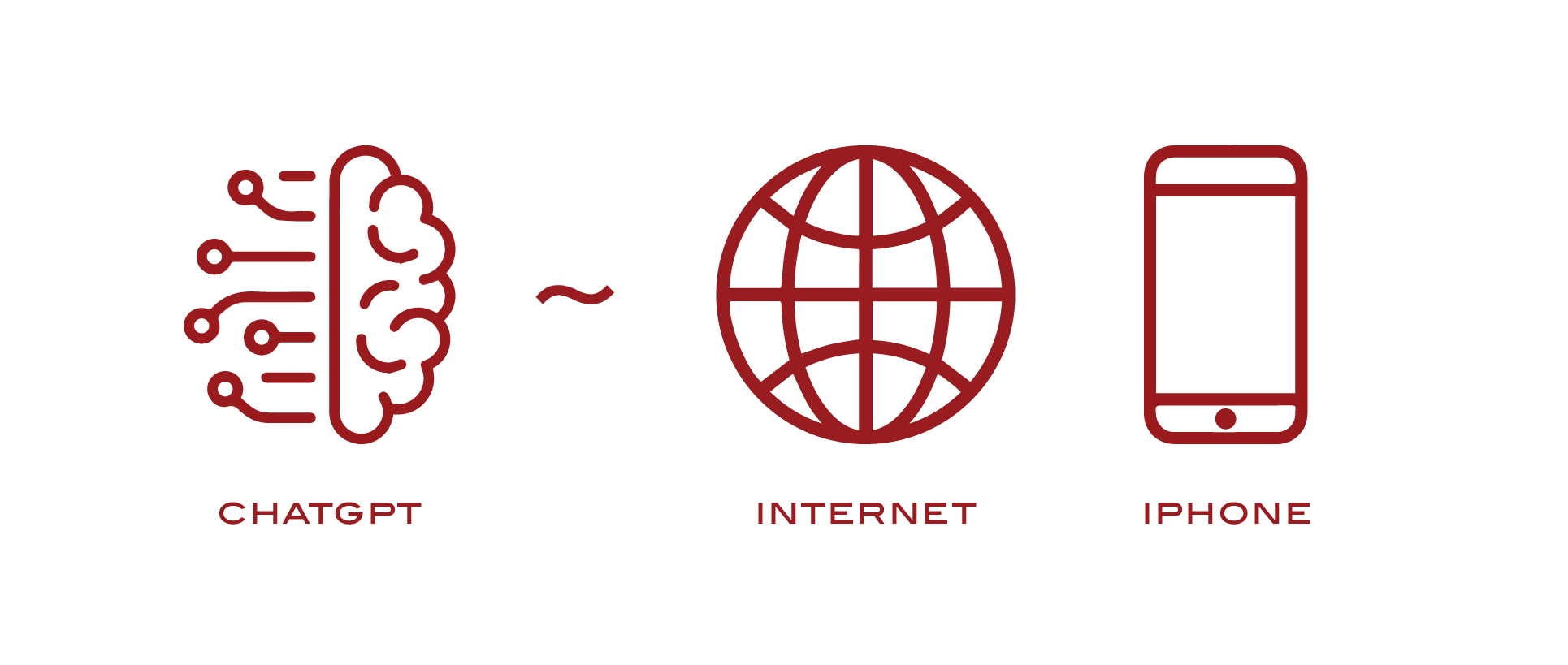

and the Exodus is Reversing
Secondly, the return-to-office (RTO) movement is escalating. The tech industry, which famously moves fast and breaks things, transitioned overnight to a dispersed operating model during lockdowns, and is now changing direction just as quickly. In May 2023, Sam Altman of Open AI called remote work “one of the tech industry’s worst mistakes in a long time.” Companies realize they can’t evolve quickly and securely in a work-from-home environment, or grow teams or cultures. Collaboration, mentorship, and training all require an office-first paradigm. Meta, Alphabet, Open AI and Zoom (ironically) are championing the cause, requiring employees to come in two to three days a week. Amazon has said employees who ignore RTO mandates may find themselves blocked from promotions. VCs are now requiring it of the companies in which they invest, including Y Combinator. Altman’s advice for AI startups? “The more unclear and early the product is, the more in-person time the team needs to grind together.”
The RTO movement is helping to reverse the exodus that occurred during the pandemic, when the Bay Area’s population declined by more than 7% between 2020 and 2022. At our new property, 99 Ocean, more than 50% of applicants are from out of state or out of town. BART ridership is beginning to recover from pandemic lows, setting weekday ridership records in August and September 2023, though the city needs to improve cleanliness and safety to support full recovery. Ferry ridership is rebounding to pre-Covid peaks. The situation on the ground in San Francisco has changed rapidly and drastically. It will take months for formal reporting to catch up to what we see unfolding.
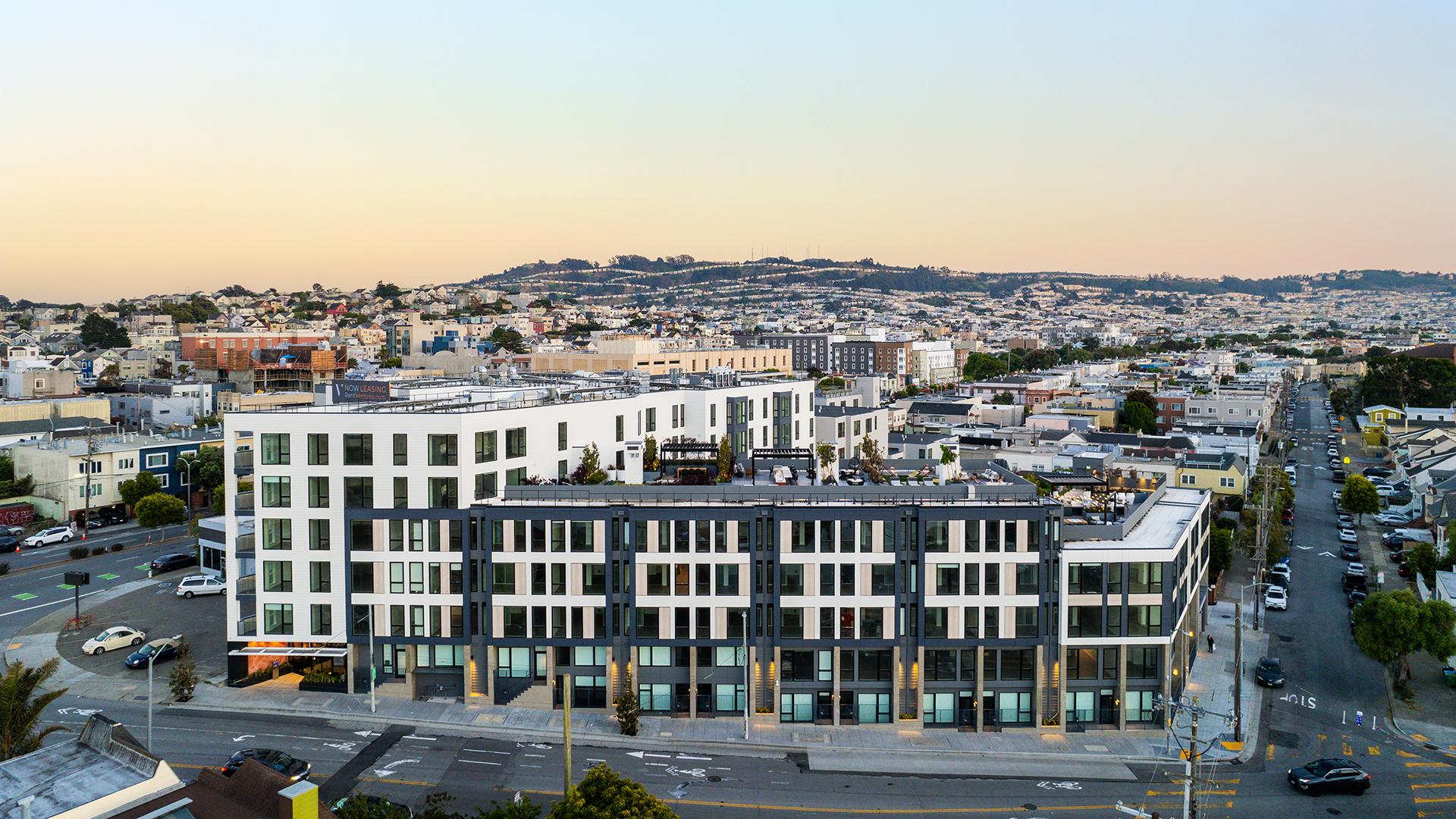

99 Ocean, San Francisco, CA
Florida, Texas and Idaho offered a fun sabbatical, but San Francisco is the real magnet for energetic innovators. In previously hot markets like Boise, population is declining and its housing market saw the nation’s biggest year-over-year price decline in June 2023. In Austin, apartment demand is waning and housing prices are falling ten times faster than the national average. A recent Redfin survey found 1 in 10 home sellers are moving because they’re being called back to the office.


San Francisco has always attracted visionaries, with its pioneering business culture, stunning mountains, beaches and natural beauty, proximity to world-class universities, strong transportation and health care systems, and a strategic location on the Pacific Rim. In addition, the city has long been a haven for people who embrace liberal values. This has become a higher-priority concern for young people in particular in a nation bitterly divided by debates over gun control, abortion, and LGBTQ+ rights. The city must address the affordable housing crisis to attract new residents and accelerate the movement’s momentum. This will require eliminating unnecessary processes, conflicting codes, and approval delays that thwart construction, and incentivizing developers and investors to produce more housing.
The city must address the affordable housing crisis to attract new residents and accelerate the movement’s momentum.
Are Sparking a Revitalization Trophy Office Space, San Francisco, CA
With RTO in full swing, employers are flocking to new construction and trophy office properties that emphasize next-generation work environments. It’s not only a flight to quality, but a flight to immersive experiences. Demand is soaring for these buildings in the downtown southern financial district and the Presidio, where vacancies are 10% to 12% versus the market average of 35%. Rents are about $120 per square foot compared to $50 in submarkets hit harder by the issues of crime and drugs, such as Midmarket, Civic Center, and SOMA. But the market as a whole is climbing back: In 2Q 2023, office leasing demand hit 5.2 million square feet, in line with the 10-year moving average.
Employers are flocking to new construction and trophy office properties that emphasize next-generation work environments.
Trophy properties, which offer dramatic Bay views, easy train and ferry access, hospitality-focused amenities, community-building events, and glamorous restaurants, such as Holbrook House and Bar Sprezzatura, are reenergizing the landscape and elevating the game. We anticipate a domino effect as more employers seek next-gen experiential design, and spaces that inspire meaningful collaboration and memorable experiences for their talent.
Meanwhile, as values for outdated, functionally obsolete office buildings reset, new capital will emerge to creatively reimagine them, as we are currently doing with 60 Spear Street. Our acquisition at $240/square foot is considerably lower than the replacement cost of $1,100 to 1,200/square foot. Leveraging the available FAR, our aim is to expand the building up to another 15,000 square feet, enriched by the structure’s architectural merits. These include a prime location with waterfront views, generous floor plates, minimal columns, high ceilings, and modern building systems. Our goal is to offer unparalleled, hospitality-level amenities to create the most differentiated high-rise building in the downtown core for less than $800/square foot, fully stabilized.
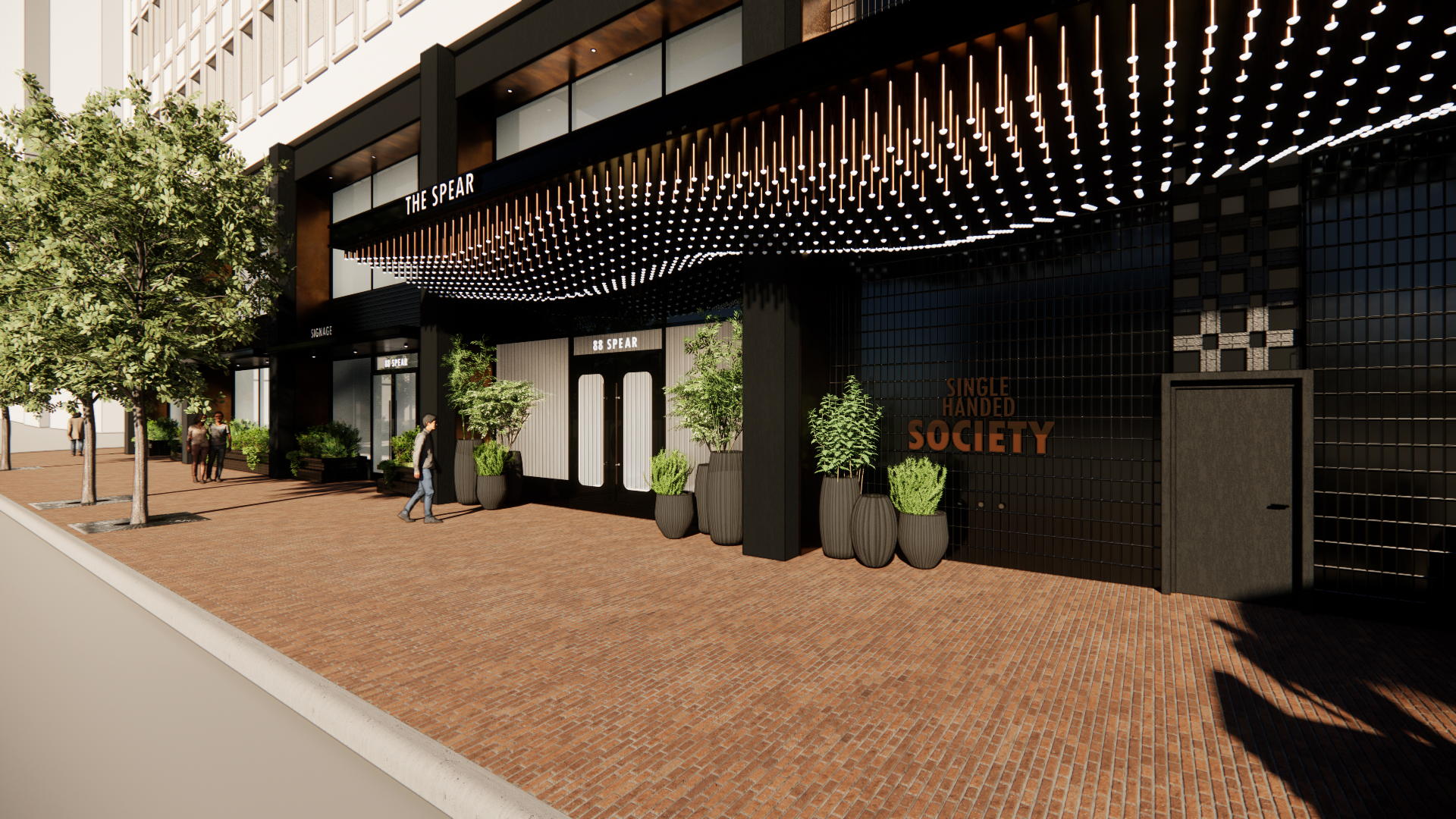

The Spear, San Francisco, CA
At current values, San Francisco is the bargain of the century. Widespread residential conversions are unlikely to be feasible, but the city can accelerate the transformation of B and C assets through tax incentives and reforms that encourage demolition or redevelopment into true mixed-use properties. The proliferation of places that truly entice people to come into the city to work and recreate will serve as a catalyst for urban vitality. Meanwhile, flourishing neighborhoods require a diversified set of uses. The city can help advance this downtown renaissance through a variety of activations, from concerts to night markets, art festivals to paddle courts. The nonprofit Illuminate, in partnership with the Civic Joy Fund, demonstrated the magic of public art with its extraordinary Market Street laser light show during the APEC Summit, signifying the unity of cooperating nations. Illuminating the Bay Bridge, where the lights were turned off in March 2023, would be another symbolic reminder to residents of the vibrancy that lies ahead.
The proliferation of places that truly entice people to come into the city to work and recreate will serve as a catalyst for urban vitality.
When a city becomes symbolic of liberal democratic values, it inevitably attracts haters. San Francisco has long had a target on its back, and the doom loop narrative is a symptom of that mentality. Although the city clearly faces intense quality of life challenges that must be managed, the media has inflated “misery porn.” The entire metro has been portrayed as a dystopian hellscape, riddled with crime, homeless encampments, open-air drug bazaars, addicts, and trash. But the worst conditions tend to be concentrated in a few square blocks in the Tenderloin, Midmarket, and SOMA. To conflate what’s happening there with neighborhoods like Russian Hill, Nob Hill, and the Marina is absurd. It’s literally a tale of two cities. As The New Yorker magazine noted in October 2023, “most of [San Francisco’s] residential neighborhoods are clean and green and bustling.”
It’s literally a tale of two cities. As The New Yorker magazine noted in October 2023, “most of [San Francisco’s] residential neighborhoods are clean and green and bustling.”
The reality is that our community is deeply united around recovery and restoration. An unprecedented level of engagement has emerged across diverse business sectors, labor, and citizens, through organizations such as TogetherSF, Neighbors for a Better SF, GrowSF, AdvanceSF, and Stop CrimeSF. Tech leaders, venture capital firms, and entrepreneurs are embracing political action for the first time — an incredible sea change. These groups are striving to bring back common sense into politics, with a focus on holistic urban renewal and equity. In addition, the community is working to redefine the city’s image, sharing civic pride on social media platforms with the hashtag “welovesf.” This is just one example of a wave of initiatives by people who love our city.
Apathy allowed the fringe left to hijack our city. Engagement will get us out. Our movement is gaining ground as San Francisco heads toward the November 2024 election, with the Mayoralty and six Board of Supervisor seats in play. The tide of public opinion has turned sharply, and people want solutions: clean and safe streets, new housing construction, and a sensible and effective approach to resolving the crises in homelessness, mental health and drug addiction. People want a government that functions. They expect leadership worthy of our great city and its enormously bright future. In short, a huge reset is required, including structural governance reform and the election of moderate candidates.
Apathy allowed the fringe left to hijack our city. Engagement will get us out.
The Asia-Pacific Economic Cooperation Summit showed us that where there’s a will, there’s a way to make San Francisco clean and safe. That it took an international spotlight for city government to do its job properly only underscores the monumental failure of leadership. Mayor London Breed must transform this veneer into a mainstay or risk losing her reelection bid.
But we are optimistic. A palpable energy and unity has returned to San Francisco. We have never seen so many creative, passionate people so in sync as they rally behind the city’s resurgence. It will take all of us to vote for common-sense leadership, cultivate the city’s intrinsic potential, and nurture the emerging boom loop. But we are confident in the people of San Francisco, our city’s greatest treasure.
As with each historic boom and bust, San Francisco is set for exponential recovery and growth. Activists, business leaders and citizens who love this city have put the catalysts in place, and transformed a doom loop into a boom loop. Never bet against us.







